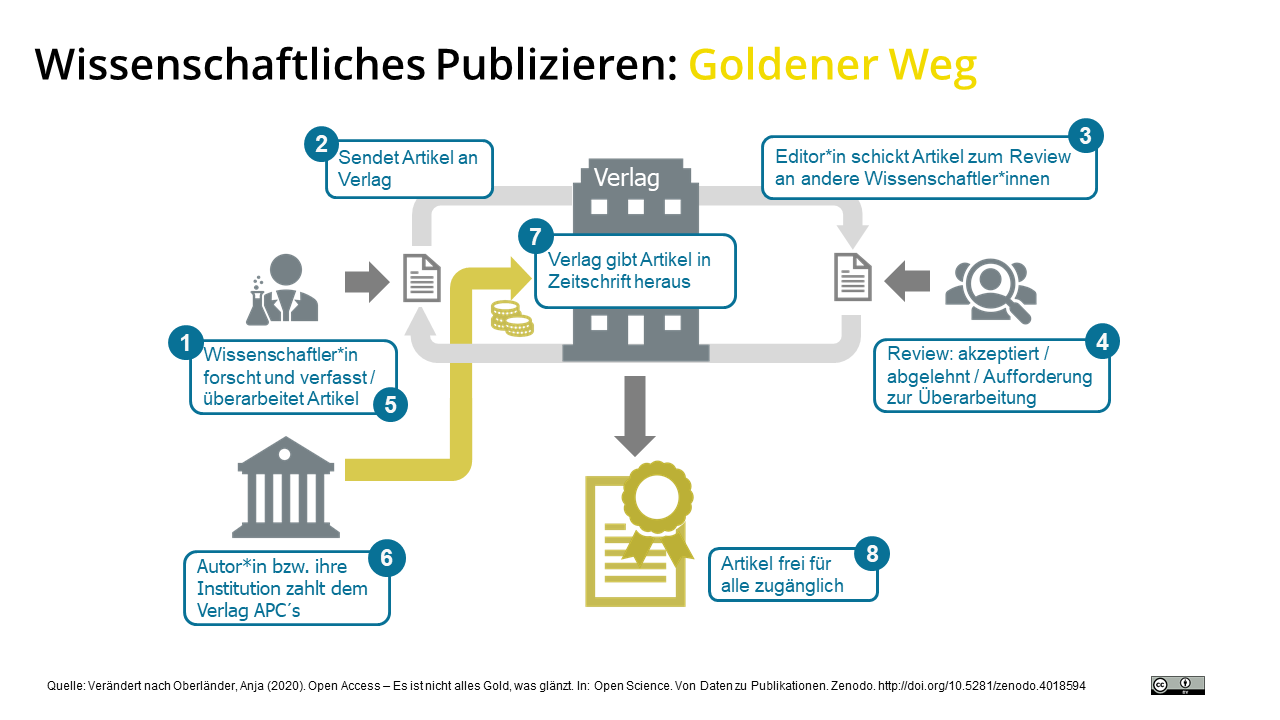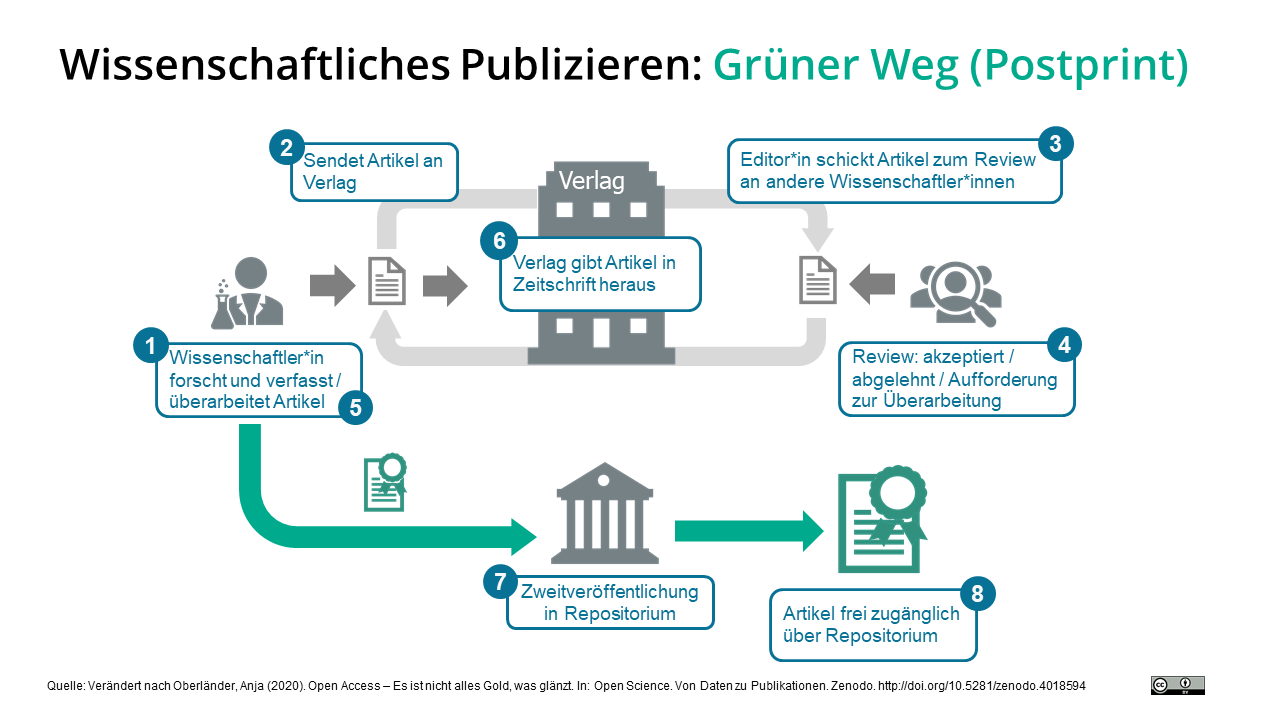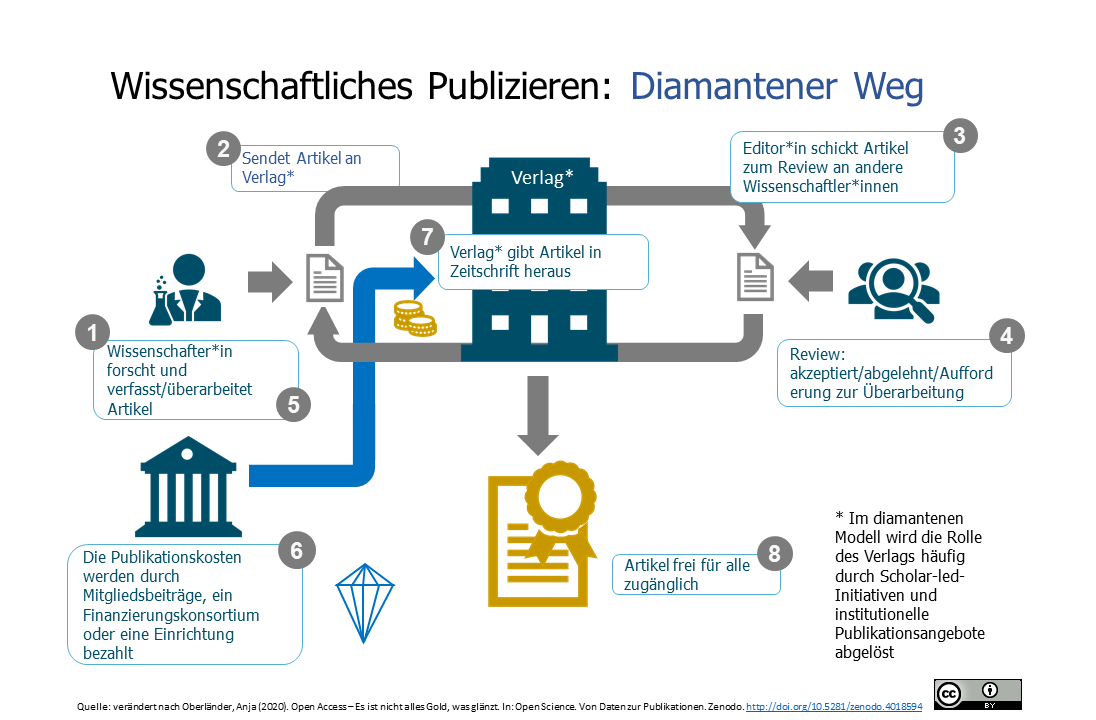What is the idea behind open access?
The term Open Access (OA) refers to free and unrestricted access to scientific information on the Internet, including scientific publications and research data. Open Access is based on the idea that results from publicly funded research should be made available to all interested parties.
Open Access offers numerous advantages for researchers: it simplifies the exchange of scientific knowledge and promotes the reproducibility and reusability of content. Authors' rights also benefit from open access: unlike traditional journals, where authors usually have to transfer their exploitation rights in full to the publisher, in open access publishing these rights generally remain with the authors. Publications are released under Creative Commons licenses, which ensure that authors are properly credited.
Numerous scientists and organizations worldwide have joined the call for open access. In accordance with the Berlin Declaration on Open Access to Scientific Knowledge, the Medical University of Vienna also supports the demand for free and unrestricted access to scientific information on the Internet (open access) and has subsequently defined this in its Open Access Policy.
Gold Open Access

Gold Open Access refers to the initial publication of scientific literature in open access journals (or other open access media).The Directory of Open Access Journals offers researchers a selection of quality-assured OA journals for open access publishing. Unlike the traditional subscription model, the costs incurred by Gold OA are borne by the authors or their institutions, and all interested parties have access to the published research results
Hybrid Open Access
Hybrid open access refers to articles that appear in closed-access journals, i.e., subscription-based journals, and can be purchased for a fee and thus made available free of charge. Publishing agreements are in place with many publishers that enable affiliates of the Medical University of Vienna to publish in open access free of charge or at a reduced cost.
Green Open Access

Green Open Access refers to the secondary publication or self-archiving of scientific literature on document servers (repositories). More and more publishers are allowing the secondary publication of their contributions in an institutional and/or subject-specific repository, and more and more researchers are taking advantage of this opportunity to accelerate and open up scientific communication.
The publication repository of the Medical University of Vienna is managed by the University Library and is called MedUni Wien ePub.
Diamond Open Access

Diamond OA (sometimes also referred to as Platinum OA) is an open access model in which neither authors nor readers incur any fees (not even indirectly, as is the case in publishing agreements, for example). Diamond models, which are often supported by colleges, universities, professional associations, etc., are generally non-commercial and non-profit, and are geared toward the interests of research and science.
At the moment DOAJ lists 824 Diamond OA Journals in the field of medicine.
Free licenses are usage licenses that allow the use, distribution, and modification of copyrighted works (e.g., Creative Commons licenses).
Creative Commons licenses (CC licenses for short) are standard license agreements that enable creators and authors to easily grant the public rights to use their works. CC licenses are composed of different building blocks, known as license modules:
- Attribution: BY
- No commercial use: NC
- No editing: ND
- Distribution under the same conditions: SA
Different combinations of these elements result in a total of six standard licenses:
- CC-BY: Attribution
- CC-BY-ND: Attribution, no editing
- CC-BY-NC: Attribution, no commercial use
- CC-BY-NC-ND: Attribution, no commercial use, no editing
- CC-BY-NC-SA: Attribution, no commercial use, distribution under the same conditions
- CC-BY-SA: Attribution, distribution under the same conditions
The CC0 license can also be used for data that is not subject to copyright protection to indicate that reuse is permitted.
Of the above, only CC-BY and CC-BY-SA comply with the open access definitions. Despite a wide range of uses, both licenses preserve the moral rights of the authors.
The term “repository” is defined as a platform for the worldwide publication and archiving of scientific publications, research data, or cultural heritage data. The publication repository of the Medical University of Vienna is maintained by the University Library and is called MedUni Wien ePub. It currently contains open access articles involving the Medical University of Vienna, approved theses from the Medical University of Vienna, and digitized materials, primarily from the holdings of the Branch Library for the History of Medicine.
DOAJ
The DOAJ (Directory of Open Access Journals) is a directory of peer-reviewed and quality-assured open access journals from all disciplines. Inclusion in the DOAJ is an important quality indicator that increases the visibility of open access articles and journals. A prerequisite for inclusion in the DOAJ is the existence of a quality assurance procedure (e.g., peer review).
DOAB
The DOAB (Directory of Open Access Books) lists freely accessible, quality-assured open access monographs in the same way as the Directory of Open Access Journals. The DOAB is developed and operated by the OAPEN Foundation. All DOAB services are free of charge and all data is freely available.
Double dipping or hybrid open access refers to subscription journals that make individual articles freely accessible in exchange for payment. This practice is highly controversial, as publishers charge institutions twice: OA publication fees from authors and subscription or license fees from libraries. For this reason, the Medical University of Vienna only supports OA publishing in hybrid journals within the framework of central OA publishing agreements in which payments for license and publication fees are jointly regulated.
Preprint
A “preprint” refers to all versions of a manuscript that have not yet been reviewed. If the preprint has been submitted to a journal, it is also referred to as a “submitted version.” Otherwise, it is referred to as the “author's original manuscript” (AOM).
Postprint
The “postprint” or accepted manuscript version is the final version that authors send to the journal or publisher after peer review and before publication. This version is often referred to as the “author manuscript,” “author version,” “author accepted version,” “final author version,” or “author accepted manuscript” (AAM).
Publishers Version
The “publishers' version” – also known as the “final version” or “version of record” – is the final, typeset and laid-out version that appears in the journal or from the publisher.
Secondary use: Secondary use generally refers to the republication of a contribution that has already been published in a journal, book, etc. The possibility of such secondary publication and the conditions under which it is permitted are usually regulated in the individual contracts or terms and conditions of the publishers. It is therefore advisable to pay attention to this possibility when concluding contracts or to negotiate it if necessary.
A good overview of the regulations of individual publishers regarding secondary publications or the conditions under which individual articles were published can be found at https://v2.sherpa.ac.uk/romeo/.
Right of secondary use: Section 37a of the Austrian Copyright Act (UrhG) is a provision that allows authors, under certain conditions, to make their contributions available on the internet regardless of the terms agreed with the respective publishers.
To whom does this right of secondary use apply?
• Only applicable if the publishing contract is subject to Austrian law. Application may already be excluded in international publishing contracts.
• Only applicable to members of academic university staff. Therefore, it does not apply if the author was not employed by the research institution at the time the contribution was created (i.e., it does not apply to students, emeritus university professors, positions financed solely by third-party funds, etc.).
• Does not apply if the contribution was created by several authors and not all of them are members of a research institution that is at least half financed by public funds.
When does the right of secondary use apply?
• The contribution must already have been published in a journal or other collection that appears in print at least twice a year. This right of secondary use does not apply to contributions published online only.
• The secondary publication may only take place 12 months after the first publication in print.
• Only applicable to the accepted manuscript version.
• No commercial purpose may be pursued.
• The source of the first publication must always be cited.
Due to the rather strict conditions for the application of the statutory right of secondary use, authors are advised to secure the right to international secondary publication in their publishing or publication contracts.
1§37a UrhG - https://www.ris.bka.gv.at/Dokument.wxe?Abfrage=Gesamtabfrage&Dokumentnummer=NOR40173343 (accessed on 18.11.2021)
